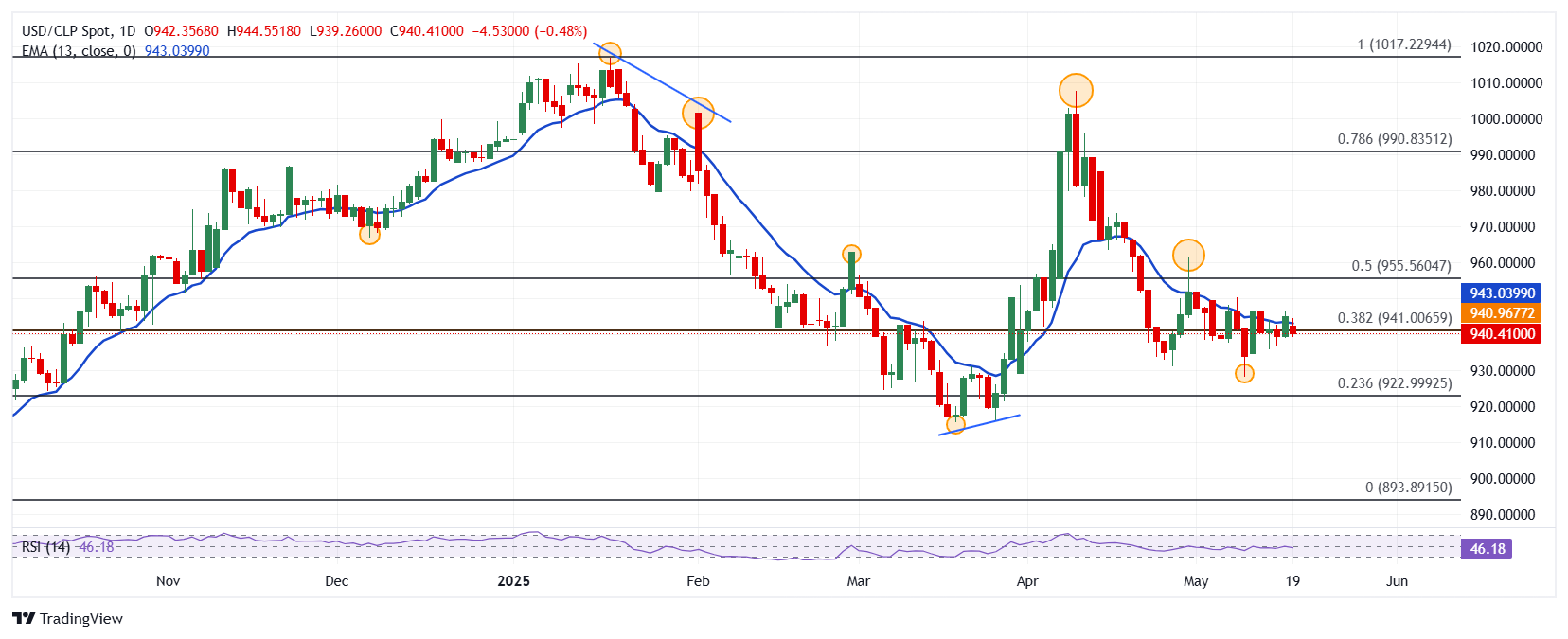- The US dollar falls to the Chilean peso, currently quoting at 940.40.
- The dollar index (DXY) loses 0.64% today, reaching May 8 at 100.06.
- Copper prices rebound a 1.23% daily, consolidating within the range of Friday’s session at $ 4,5973 per pound.
- The Moody´s credit agency cut down the sovereign qualification of the United States from AAA to AA1, highlighting tax risks.
- Chile’s gross domestic product increased 2.3% in the first quarter of the year, exceeding market forecasts of 2%.
The USD/CLP established a maximum of the day in 944.55, finding vendors that dragged a daily minimum in 939.75. At the time of writing, the USD/CLP goes back 0.47%, operating when writing 940.40.
The Chilean weight gains ground after the sovereign qualification reduction of Moody´sa USA.
The Moody´s qualification agency adjusted down the qualification of the sovereign debt of the United States to AA1 from AAA. According to Moody´s, debt financing costs are higher than entities with similar qualifications.
The dollar index (DXY) has a fall of 0.64% today, reaching minimal not seen since May 8 in 100.06.
On the other hand, the Gross Domestic Product of Chile registered an increase of 2.3% corresponding to the first 2025 quarter, improving the expectations of the consensus of 2%.
The price of copper rises 1.23% today, oscillating within the operational range of the previous session at $ 4,5973 per pound,
In this context, the Chilean weight gains traction, while the USD/CLP loses 0.47% on Monday, staying within Friday’s range at 940.40.
Technical levels in the USD/CLP
The USD/CLP established a short -term resistance given by the maximum of April 30 in 961.65. The next key resistance is at 1,007.73, maximum of April 9. Down, the immediate support is observed at 928.21, minimum of May 9.
USD/CLP daily graphics

US dollar FAQS
The US dollar (USD) is the official currency of the United States of America, and the “de facto” currency of a significant number of other countries where it is in circulation along with local tickets. According to data from 2022, it is the most negotiated currency in the world, with more than 88% of all global currency change operations, which is equivalent to an average of 6.6 billion dollars in daily transactions. After World War II, the USD took over the pound sterling as a world reserve currency.
The most important individual factor that influences the value of the US dollar is monetary policy, which is determined by the Federal Reserve (FED). The Fed has two mandates: to achieve price stability (control inflation) and promote full employment. Its main tool to achieve these two objectives is to adjust interest rates. When prices rise too quickly and inflation exceeds the 2% objective set by the Fed, it rises the types, which favors the price of the dollar. When inflation falls below 2% or the unemployment rate is too high, the Fed can lower interest rates, which weighs on the dollar.
In extreme situations, the Federal Reserve can also print more dollars and promulgate quantitative flexibility (QE). The QE is the process by which the Fed substantially increases the flow of credit in a stuck financial system. It is an unconventional policy measure that is used when the credit has been exhausted because banks do not lend each other (for fear of the default of the counterparts). It is the last resort when it is unlikely that a simple decrease in interest rates will achieve the necessary result. It was the weapon chosen by the Fed to combat the contraction of the credit that occurred during the great financial crisis of 2008. It is that the Fed prints more dollars and uses them to buy bonds of the US government, mainly of financial institutions. Which usually leads to a weakening of the US dollar.
The quantitative hardening (QT) is the reverse process for which the Federal Reserve stops buying bonds from financial institutions and does not reinvote the capital of the wallet values that overcome in new purchases. It is usually positive for the US dollar.
Source: Fx Street
I am Joshua Winder, a senior-level journalist and editor at World Stock Market. I specialize in covering news related to the stock market and economic trends. With more than 8 years of experience in this field, I have become an expert in financial reporting.







